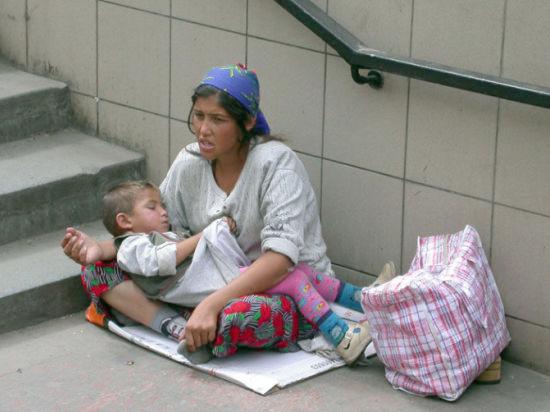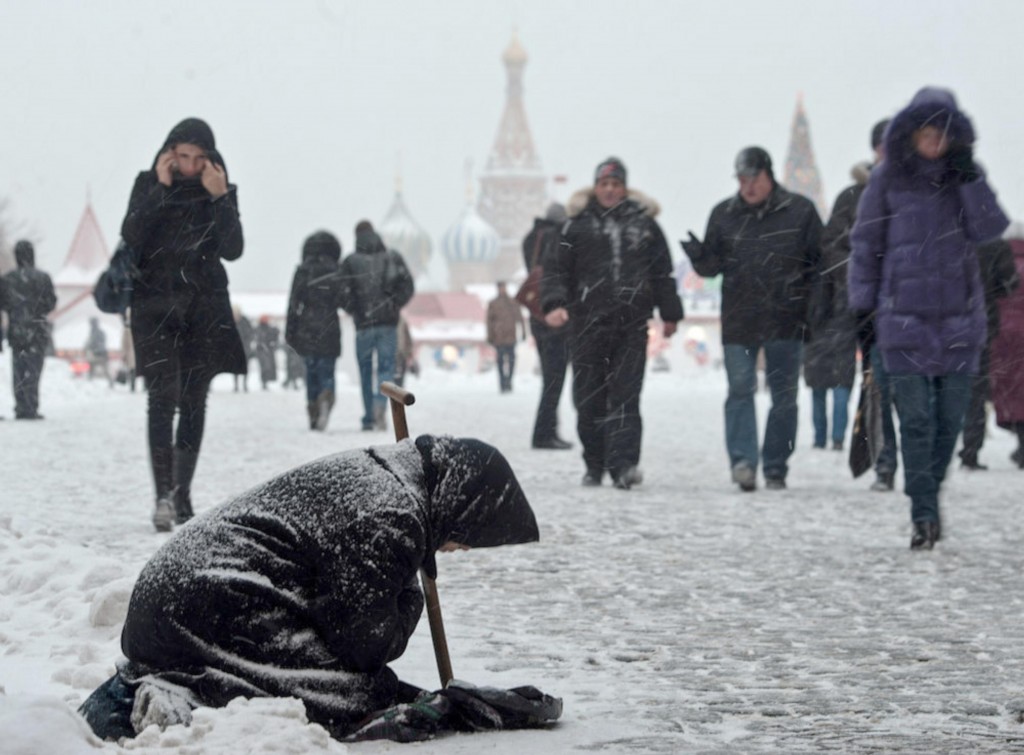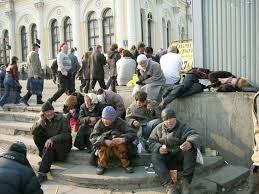Lately there were a lot of publications in Russia devoted to problem of paupers. In my opinion the most enlightening was an interview with Oleg Melnikov, the head of non-governmental organization “Alternative”, broadcast by Internet TV station “Rain”. “Alternative” was created with the purpose to deal with the problem of beggars in Russia.
According to Melnikov one cannot just stand with outstretched hand by his or her own will in Moscow. There are only several places in the capital, where beggars can stand, and all these “territories” are divided between so-called “masters”. On average, use of one “territory” costs about 100 thousand rubles ($3300) a month. This money a “master” pays to the police, who “roofs” his business. A “master” usually can place up to four people on one “territory”. Each beggar earns daily seven to ten thousand rubles. The begging business is criminalized, but decentralized. There doesn’t exist a Mafia that controls all beggars. There are many different “masters”, who control different “territories”.
Moscow beggars fall into two categories: cheaters and slaves. Slave labor is widely used in begging business. The beggars rarely personally spend the money that they obtained by begging. They usually live in a place given to them by their masters, and receive necessary food from these masters. Sick beggars are not cured because the more pitiful they look, the more money they make. Almost all people with disabilities, who can be found in subways and on the streets, are someone’s property.
Until 2008, most of the beggars were from Central Asia. They were illegally brought to Russia and sold. At some point Muscovites became more nationalistic and stopped giving money to the people who look Asian. Then slave traders started bringing beggars from Ukraine, mainly from the Odessa region. Now about 90% of beggars on Moscow streets are from Ukraine.
The people are not always forcibly sold into slavery and taken away from their homes. In most cases, enslaving is done by means of deception. For example, considering the bad economic situation in Ukraine, a lonely old woman is offered a job in Moscow, and she agrees to enter into slavery voluntarily. In some cases, beggars can work a season and then get released. But in other cases, such people are exploited to the end.
The slave–beggars have their prices. A “grandma” costs 30,000 rubles ($1000). A woman of absolutely any age can be disguised as a grandmother–beggar. An “invalid” costs 50,000 rubles ($1700).
 A child costs 100,000 rubles ($3300). The children are usually bought from migrant families or from alcoholics.
A child costs 100,000 rubles ($3300). The children are usually bought from migrant families or from alcoholics.
The women, who beg with children, are called “Madonnas”. Those who tried to study the activity of “Madonnas” were shocked to see that children in their arms usually sleep all day long. These children are under the influence of drugs or alcohol, and their life is very short.
 The problem is that these children cannot be traced by police, because prior to getting a birth certificate the newborn children are not registered anywhere. The same “Madonna” can beg with several completely different children, showing the same birth certificate. The police can do nothing about it, because the certificates have no children’s signs of identification.
The problem is that these children cannot be traced by police, because prior to getting a birth certificate the newborn children are not registered anywhere. The same “Madonna” can beg with several completely different children, showing the same birth certificate. The police can do nothing about it, because the certificates have no children’s signs of identification.
In spite of the fact that the Criminal Code’s Article 151 forbids “involvement of a minor in begging”, it is very difficult to bring the organizers of such activities to justice. Formally, a sleeping child in the hands of women is not engaged in begging.
NTV, one of the biggest Russian TV stations, made an experiment.
In order to learn how begging business works in Moscow a professional actress Alla S. had dressed as a beggar and went to the porch of the temple of Christ the Savior, the biggest Moscow temple. The experiment was recorded and broadcast.
The actress quickly got used to the role, actively begging, and the newcomer was making much better “business” than others beggars on the porch. Old-timers got nervous. One of them in a friendly but convincing tone offered Alla S. to leave the territory ASAP. She explained to Alla that Alla is inviting troubles: the people who oversee the situation on the porch of the temple can come any minute.
She said: “I’m telling you – it is dangerous here, very dangerous. They walk around with knives, with guns. “
The pauper admitted that she pays to the “cover” 1000 rubles ($33) per day. Suddenly, she got silent. The racketeers had arrived. One of them, a middle-aged man in sportswear – called Alla S. to talk. The racketeer was serious and his speech was short. Alla S. had to leave.
NTV also interviewed several paupers on Moscow streets.
Legless invalid Ivan Malyshyts, who was asking for money commuters in the underground passage, said that he and his girlfriend escaped from a provincial shelter in search of better life. He immediately fell into the hands of clever businessmen. He was forced to beg portraying an Afghan veteran.
He said: “I was working in a summer uniform and a camouflage hat. It was cold. Well, how much could I make a day? Not more then three thousand. They said: “it is not enough.” I said: “Then I will not work.” They beat me up. ”
Another legless pauper Vyacheslav, seemed to be satisfied with his life. He admitted that he was living with Gipsy “masters”. “At least I always have a roof over my head”, – he says, – “They look after me, I am always clean, shaven, neat.”



